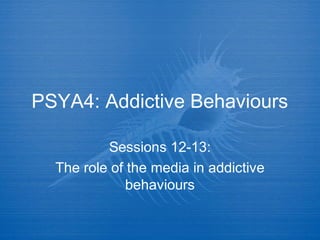
Media and addiction
- 1. PSYA4: Addictive Behaviours Sessions 12-13: The role of the media in addictive behaviours
- 2. Starter List five different forms of media Give at least three ways that messages promoting addictive behaviour could be transmitted through the media. Give at least three ways that messages preventing addictive behaviour be transmitted through the media. Name a psychological approach that is relevant to media influence on addictive behaviour
- 3. Different forms of Media Film TV programmes Radio broadcast Newspapers and magazines Internet Campaign Leaflets Posters (Advertising Hoardings)
- 4. Aims & Objectives… AIMS: OBJECTIVES: 1)To examine research into the portrayal of addiction in the media, including film, advertisements and health campaigns 2) Evaluate the above research in terms of supporting/refuting research 3) Provide synoptic links (at least three)
- 5. Films-Activity List at least three films where addictive behaviour has been portrayed What was the addictive behaviour? Was it realistically portrayed? Were the positive or negative effects emphasized? Do you think the films had any influence on the opinions and behaviours of the audience
- 6. Trainspotting… QuickTime™ and a decompressor are needed to see this picture.
- 7. Film and Addiction Gunasekera et al (2005) Content analysis of 87 of the top 200 grossing films in the last 20 years Recorded sexual activity (including STD prevention), birth control and drug use Use text book to write down the specific findings of the study (454)
- 8. Film Sulkunen (2007) Looked at 140 scenes from 47 films depicting use of alcohol, drugs, smoking, gambling and sex Films about drug users like Trainspotting (1996) and Human Traffic (1999) presented scenes of drug competence and enjoyment of the effects which was often contrasted with the dullness of ordinary life Q: What type of reinforcement Is this?
- 9. Evaluation (AO2) To what extent do these films have an impact on society? Some evidence does suggest that they do. E.g. Dalton et al (2003) showed a positive correlation between adolescent exposure to smoking in movies and the likelihood of starting to smoke. However, there are issues here with causality… Sargent and Hanewinkel (2009) surveyed 4384 adolescents (11-15). Exposure to movie smoking over the subsequent year was strong predictor of whether they began to smoke a year later…
- 10. AO2 Studies are correlational and somewhat reductionist. A more holistic approach is important in considering influences on addiction, such as… Boyd (2008) argues that films do frequently represent the negative consequences of alcohol and drug dependence, therefore… There is an important discussion about free will and determinism relating to media representations of addiction (elaborate..)
- 11. Advertising and Media Campaigns Health Campaigners use television and the internet in an attempt to raise awareness and prevent the number of addictions taking place to begin with. Campaigns and health promotion can also be implicitly delivered by through the plots of TV or radio soap operas, where the audience tends to identify better with the characters involved, such as plots about addiction in Hollyoaks, aimed at young people.
- 12. Research Bennett et al(1991) evaluated the effect of a BBC TV series on alcohol use entitled ‘Pssst, the Really Useful Guide to Alcohol’. Viewers of the series were compared to controls who did not watch the programme. The results showed an improvement in alcohol related knowledge, but they did not show a change in attitudes to drinking or a lowering of consumption.
- 13. TV (research) Kramer et al. (2009) assessed the effectiveness of a five week TV intervention self-help designed to reduce problem drinking called ‘Drinking Less? Do It Yourself!’ The intervention group was more successful than a control group in achieving a low-risk drinking pattern. The effect was still prevalent after three months.
- 14. Activity-The third Person Effect Use the text book (page 456) to outline research into the ‘Third Person Effect’ (Youn et al. (2000)) What is it and outline how it affects media campaigns Evaluate the research giving three points
- 15. Internet TV and internet has been used to warn UK teenagers about the dangers of cocaine using a fictional dog called ‘Pablo’ (see clips)… The dog seeks out cocaine users to find out what negative things happen to them after taking the drug.
- 16. AO2 Bennett (1991) - little change in actual behaviour despite raising awareness following BBCs ‘Pssst, the Really Useful Guide to Alcohol’. Kramer et al.(2009) study - (Drinking Less TV series) can be criticized as there were important differences between the control and intervention group. The intervention group had weekly visits. This extra attention may have resulted in a positive outcome for the group. Also the ‘waiting list’ control group was aware that it would receive treatment soon and so might have delayed changing behaviour producing a false difference between the two groups
- 17. Evaluation Hornick et al. (2008) argues that expensive anti drug media campaigns in the US have not worked for two reasons: Giving the same message that young people have heard many times before (lack of novelty) Advertising giving an implicit message that drug use was common-place and so actually promoting things like marijuana use with young people thinking it was the norm (conformity effect)
- 18. Overall Research on media effects is inconclusive Relationship between advertising and addictive behaviour is correlational (no cause and effect) There could be different media effects for different addictions Can you think of a debate that would be appropriate?
